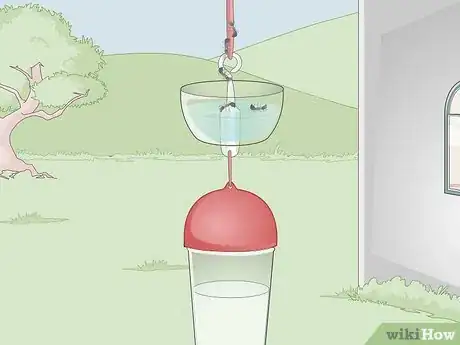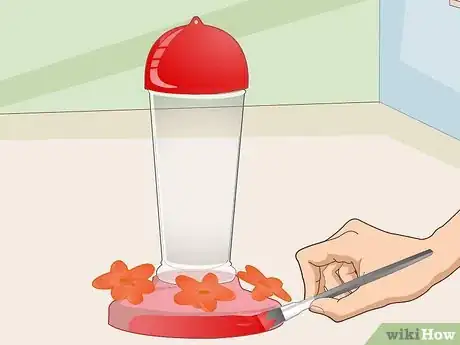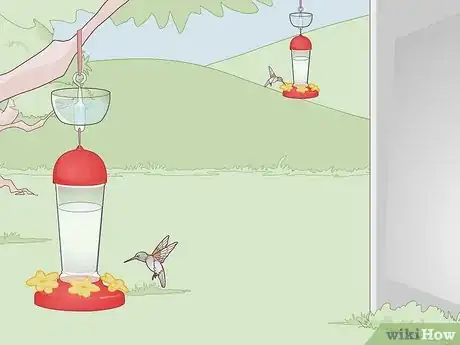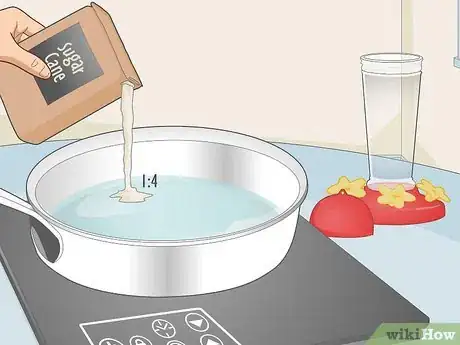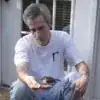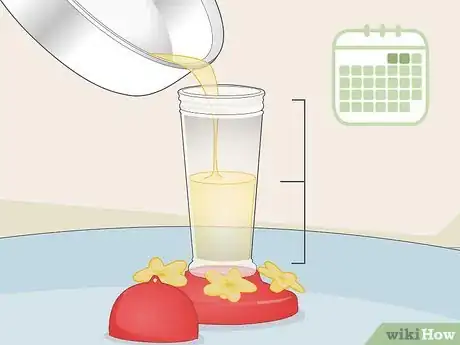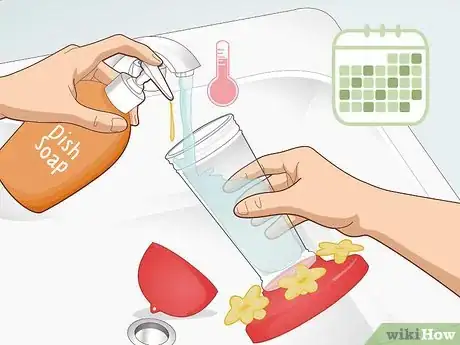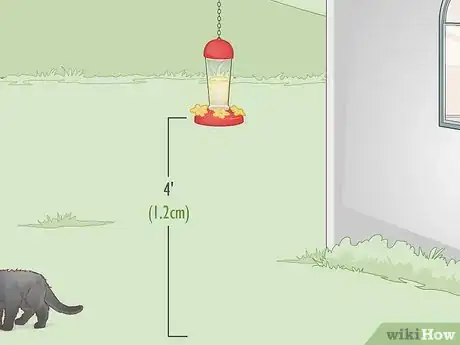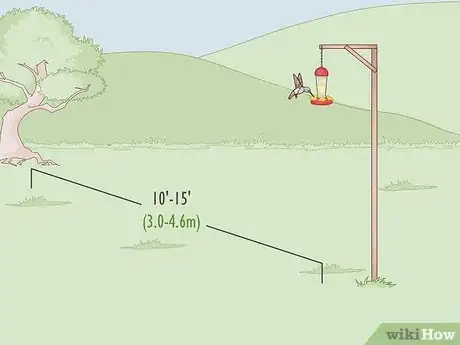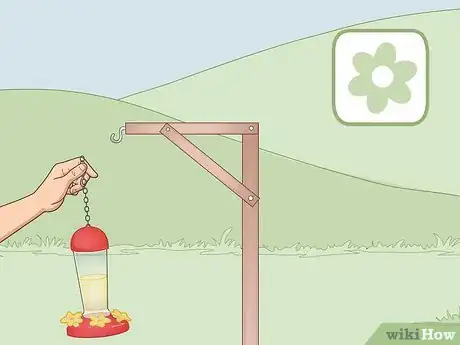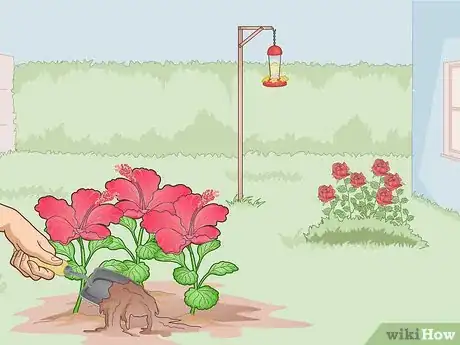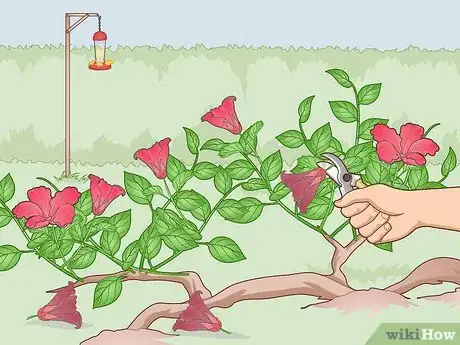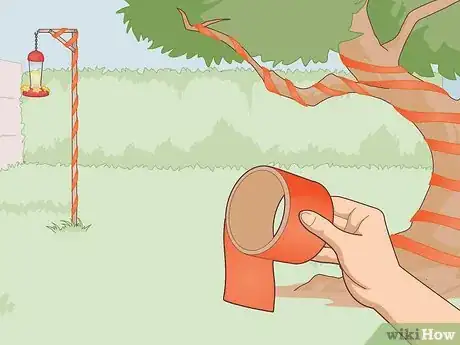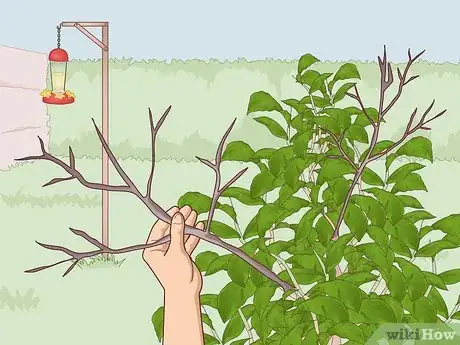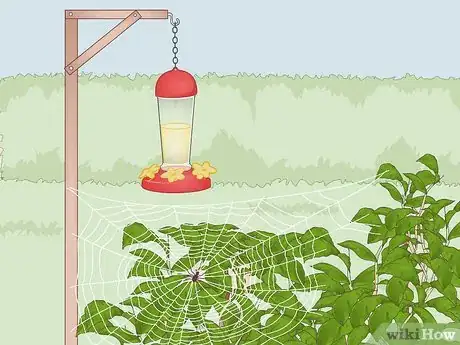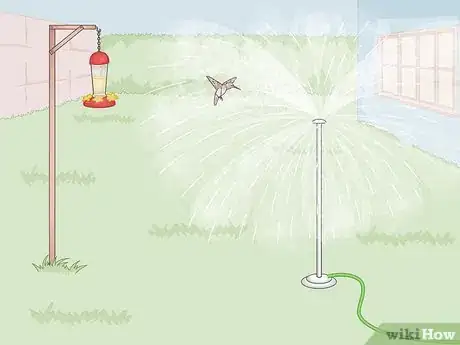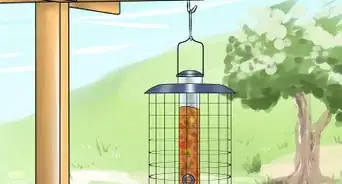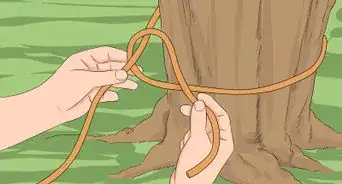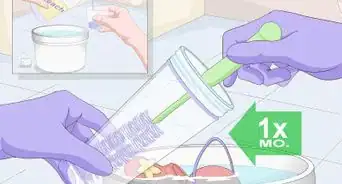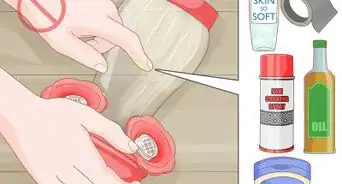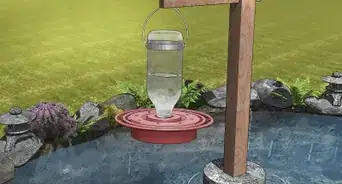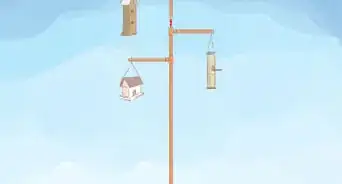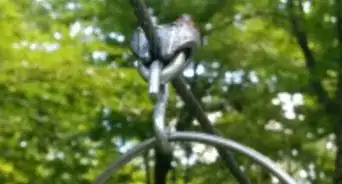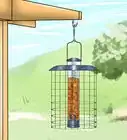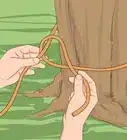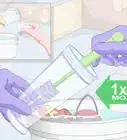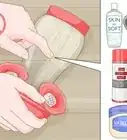This article was co-authored by Jeff Jones. Jeff Jones is a Bird Specialist based in Nashville, Tennessee. He is the writer of BirdOculars, a website dedicated to helping people become better birders. He has over 18 years of experience and specializes in feeding birds and wildlife. Jeff experiments to find ways to encourage birds he wants to study and his website help others to do the same.
There are 9 references cited in this article, which can be found at the bottom of the page.
This article has been viewed 13,166 times.
Hummingbirds are beautiful little creatures that are a joy to watch! If you want more of them to visit, you’ll need to know how to entice them to your feeder. Planting some of their favorite flowers and offering some amenities like perches and misters near your feeder can help create a perfect hummingbird hangout. Properly cleaning the feeder will ensure the birds stay healthy and filling it with their favorite meal will keep them coming back for more.
Steps
Choosing the Best Feeders
-
1Buy a feeder with an ant moat to keep ants out of the nectar. Ant moats are bowls filled with water that are located above or near the center of the feeder. It will trap ants that are trying to get to the nectar. As a plus, hummingbirds love to eat ants for protein and will appreciate the additional snack![1]
- If you live in a hot, dry area, the water in the ant moat may evaporate quickly so you may need to refill it every other day.
- If your feeder doesn’t have an ant moat, you can also apply petroleum jelly to the chain above the feeder.[2]
-
2Purchase a saucer feeder made of UV-resistant plastic for durability. Saucer-shaped feeders can be easier to clean and will give you a better view of the hummingbirds. UV-resistant plastic is more durable and will keep the nectar from evaporating quickly (especially on hot days).[3]
- Some saucer feeders come with a hanging wire and some have a suction cup on one side so you can attach it to an outside window.
- Hummingbirds have no preference what style of feeder you have—they just care about the food!
- You can also find ornate glass feeders but these can be harder to clean.
Advertisement -
3Repaint old feeders a vibrant red or orange hue. Feeders with red or orange paint can look dull over time, and hummingbirds are more likely to stop when they see bright, vivid reds and oranges. Use acrylic paint or nail polish to repaint the feeder—just make sure it's dry before you refill and rehang it.
- Bright magenta will also attract hummingbirds.
-
4Use multiple feeders to attract more hummingbirds. The more opportunities you give the hummingbirds to eat, the more likely it is they’ll flock to the buffet of feeders. If you only have 1 feeder, add 1 to 3 more to encourage more hummingbirds to stop by. Adding another feeder will also help topple the reign of any dominant male hummingbirds in the area.[4]
- If you have a dominant male that’s bullying other hummingbirds away from the feeder, place 2 or 3 more feeders within view of the existing feeder. That way, more hummingbirds can come and outnumber the dominant male.
Filling the Feeder with Nectar
-
1Provide hummingbirds' favorite food of 1 part cane sugar to 4 parts water. Depending on the size of your feeder, stir together sugar and water until the sugar is dissolved. To kill bacteria and keep it from spoiling too soon, bring the sugar-water mixture to a boil and let it cool before putting it in the feeder.[5] [6]
- Don’t use honey, artificial sweeteners, turbinado sugar, raw sugar, powdered sugar, organic sugar, or brown sugar.[7]
- Spring water is best, but tap water will do—don’t use distilled water.
- While it’s common to add red food dye to the nectar to make it more attractive-looking, it’s best to avoid doing this because it could potentially harm the hummingbirds.
- Refrigerate the excess sugar water in an airtight container for up to 7 days.[8]
-
2Fill the feeder about halfway full to provide enough nectar for 1 or 2 days. There’s no need to fill the feeder to the top, especially if you’re not sure how many hummingbirds your feeder will attract. If you notice the nectar is gone in 1 day due to lots of visitors, fill it about 3/4 of the way full.[9]
- Most feeders hold anywhere from 8 fluid ounces (240 mL) to 12 fluid ounces (350 mL) of liquid but you can find reservoir feeders that hold up to 32 fluid ounces (950 mL).
-
3Clean the feeder every 2 to 3 days with warm water and mild dish soap. Scrub the feeder with a bottle brush to reach every nook and cranny. Hummingbirds dip their tongues into the water as they drink, which can spread pathogens that can make them sick. A good rule of thumb: clean the feeder as you would your own drinking glass.[10]
- Hummingbirds will typically eat up all the nectar within 4 to 5 days, but if you notice any leftover nectar, go ahead and clean the feeder before refilling it (don’t just top it off!).
- Hot weather can evaporate the sugar-water faster, so check the feeder every day if it’s over 90°F (32°C) to see if you need to clean and refill it.
- If you notice the sugar-water is cloudy or growing mold, wash the feeder right away.
Positioning the Feeder
-
1Hang the feeder at least 4 feet (1.2 m) off the ground to keep pests away.[11] Cats, opossums, squirrels, and other pests might be drawn to the sugar-water, so hang the feeder high enough off the ground so they can’t get to it. Cats can be ninjas, so make sure there are no places where cats can leap from to reach the feeder.[12]
- Make sure there’s no foliage underneath the feeder because sugar-water may drip down onto the leaves and attract pests.
-
2Place the feeder 10 ft (3.0 m) to 15 ft (4.6 m) away from cover. Hummingbirds love to sip on nectar in spots that are near to shade or any hiding place. Put the feeder 10 ft (3.0 m) to 15 ft (4.6 m) away from a shrub, tree, or other hiding place so the hummingbird can feed and rest in the safety of shade.[13]
- A porch of overhand of your house will also work. It will also allow you to watch your beautiful visitors close up!
- Shade will keep the sugar water from spoiling too soon.
-
3Put your feeder up in the early spring to attract early-migrators. Don't wait until you see hummingbirds around to put your feeder out—start advertising your feeder as a good rest stop early to entice birds that migrate sooner than others. Early spring is a good time, but you can put it up sooner or later depending on where you live.[14]
- If you live near the Gulf Coast, put your feeder up at the beginning of March.
- If you live in the northern U.S. or Canada, you can wait until the end of March.
Creating an Attractive Area around the Feeder
-
1Plant plenty of flowers that have red blooms near your feeder. When hummingbirds see bright red blooms, they think they're in for a tasty treat! Daylily, columbine, cardinal flowers, penstemon, bee balm, hibiscus, peonies, and oriental poppy are all vibrant flowers that hummingbirds will love.[15]
- Hummingbirds see ultraviolet light, so all colors—red especially—appear much more vivid to them than it does to us.
- Be sure to look up your planting zone for particular flowers.
-
2Deadhead the flowers in your garden to encourage more blooms. The more blooms you have, the more likely it is that hummingbirds will come! Deadheading means removing old, wilted blossoms and seed heads (the dried flowering or fruiting part) from plants that are currently blooming.
- In a way, this tricks the plant into thinking it's not done blooming yet.
- This is most effective if your feeder is placed near the flowers or within viewing range.
-
3Wrap red or orange plastic ribbon around something near the feeder. Purchase bright red or orange surveyor’s tape from any hardware store and cut it into 12 in (30 cm) pieces so you can tie it around tree trunks, railings, or anywhere near the feeder. The bright color will pique the interest of high-flying hummingbirds, enticing them to stop and check out your feeder and flowering gardens.
- Surveyor’s tape is also called flagging tape and can cost anywhere from $1.50 to $6.00.
-
4Provide a "snag" perch near the feeder for the hummingbirds to rest. Hummingbirds like to rest at the end of an exposed branch so they can see any rivals or predators approaching. Make a snag perch by inserting a dead branch into the ground so it stands upright. Put it somewhere within viewing range of the feeder or within 50 feet (15 m).
- Hummingbirds' wings beat 80 times per second—they'll be happy to stop and rest if you provide a good perch!
-
5Let spiders keep their webs near the feeder. Hummingbirds use spiderweb silk to secure their nests, so the more webs you have around, the more likely it is that you'll have some quick-winged visitors. They also love to steal the spiders' dinners—the insects are a great source of protein![16]
- However, orb-weaver spiders eat hummingbirds, so if you notice this type of spider setting up a home near the feeder, go ahead and get rid of the web.
-
6Get a mister for your yard or garden and place it near the feeder. A mister attaches to a regular garden hose and will spray a fine mist into the air. Hummingbirds love to fly through the mist before they rest to preen. As a plus, you’ll get to watch the birds play in the mist!
- You can buy a mister at most garden or lawn-care stores.
Expert Q&A
-
QuestionWhere should you hang a bird feeder?
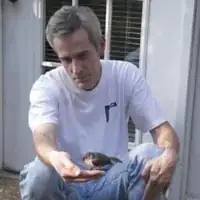 Jeff JonesJeff Jones is a Bird Specialist based in Nashville, Tennessee. He is the writer of BirdOculars, a website dedicated to helping people become better birders. He has over 18 years of experience and specializes in feeding birds and wildlife. Jeff experiments to find ways to encourage birds he wants to study and his website help others to do the same.
Jeff JonesJeff Jones is a Bird Specialist based in Nashville, Tennessee. He is the writer of BirdOculars, a website dedicated to helping people become better birders. He has over 18 years of experience and specializes in feeding birds and wildlife. Jeff experiments to find ways to encourage birds he wants to study and his website help others to do the same.
Bird Specialist I would suggest that you do not hang a bird feeder from a tree, due to insects and predators. I would recommend placing any bird feeders on a baffled pole to keep predators away.
I would suggest that you do not hang a bird feeder from a tree, due to insects and predators. I would recommend placing any bird feeders on a baffled pole to keep predators away. -
QuestionHow far should a bird feeder be from the house?
 Jeff JonesJeff Jones is a Bird Specialist based in Nashville, Tennessee. He is the writer of BirdOculars, a website dedicated to helping people become better birders. He has over 18 years of experience and specializes in feeding birds and wildlife. Jeff experiments to find ways to encourage birds he wants to study and his website help others to do the same.
Jeff JonesJeff Jones is a Bird Specialist based in Nashville, Tennessee. He is the writer of BirdOculars, a website dedicated to helping people become better birders. He has over 18 years of experience and specializes in feeding birds and wildlife. Jeff experiments to find ways to encourage birds he wants to study and his website help others to do the same.
Bird Specialist In order to keep birds and pests from entering your home. Make sure your feeders are more than 30 feet away from the house.
In order to keep birds and pests from entering your home. Make sure your feeders are more than 30 feet away from the house.
Warnings
- Dirty feeders can grow bacteria that may kill hummingbirds, so be sure to clean your feeder.[18]⧼thumbs_response⧽
Things You'll Need
Choosing a Feeder
- Ant moat
- Red or orange acrylic paint (or nail polish)
- Saucer-feeder
- Additional feeders (optional)
Filling the Feeder
- White granulated sugar
- Water
- Mild dish soap (for cleaning)
- Bottle brush (for cleaning)
- Saucepan (optional, for boiling sugar water)
Positioning the Feeder
- Branch or hanging hook at least 4 feet (1.2 m) off the ground
Creating an Attractive Area Around the Feeder
- Red or orange flowers
- Surveyor's tape (red or orange)
- Loose branch (for snag perch)
- Spiderwebs
- Garden mister
References
- ↑ http://www.kern.audubon.org/hummer_feeding.htm
- ↑ http://www.seaandsageaudubon.org/BirdInfo/BirdProblems/HummingbirdCare.pdf
- ↑ http://home.olemiss.edu/~larryago/hummingbirds/feeder.html
- ↑ http://www.seaandsageaudubon.org/BirdInfo/BirdProblems/HummingbirdCare.pdf
- ↑ Jeff Jones. Bird Specialist. Expert Interview. 13 May 2021.
- ↑ http://www.kern.audubon.org/hummer_feeding.htm
- ↑ https://www.hummingbirdsociety.org/feeding-hummingbirds/
- ↑ Jeff Jones. Bird Specialist. Expert Interview. 13 May 2021.
- ↑ http://www.kern.audubon.org/hummer_feeding.htm
- ↑ http://www.seaandsageaudubon.org/BirdInfo/BirdProblems/HummingbirdCare.pdf
- ↑ Jeff Jones. Bird Specialist. Expert Interview. 13 May 2021.
- ↑ https://www.hummingbirdsociety.org/feeding-hummingbirds/
- ↑ http://www.gardening-for-wildlife.com/hummingbird-feeder-placement.html
- ↑ http://www.rubythroat.org/FeedingHintsMain.html
- ↑ https://askabiologist.asu.edu/vision-and-color
- ↑ https://ucanr.edu/blogs/blogcore/postdetail.cfm?postnum=29582
- ↑ https://www.hummingbirdsociety.org/feeding-hummingbirds/
- ↑ http://www.seaandsageaudubon.org/BirdInfo/BirdProblems/HummingbirdCare.pdf
